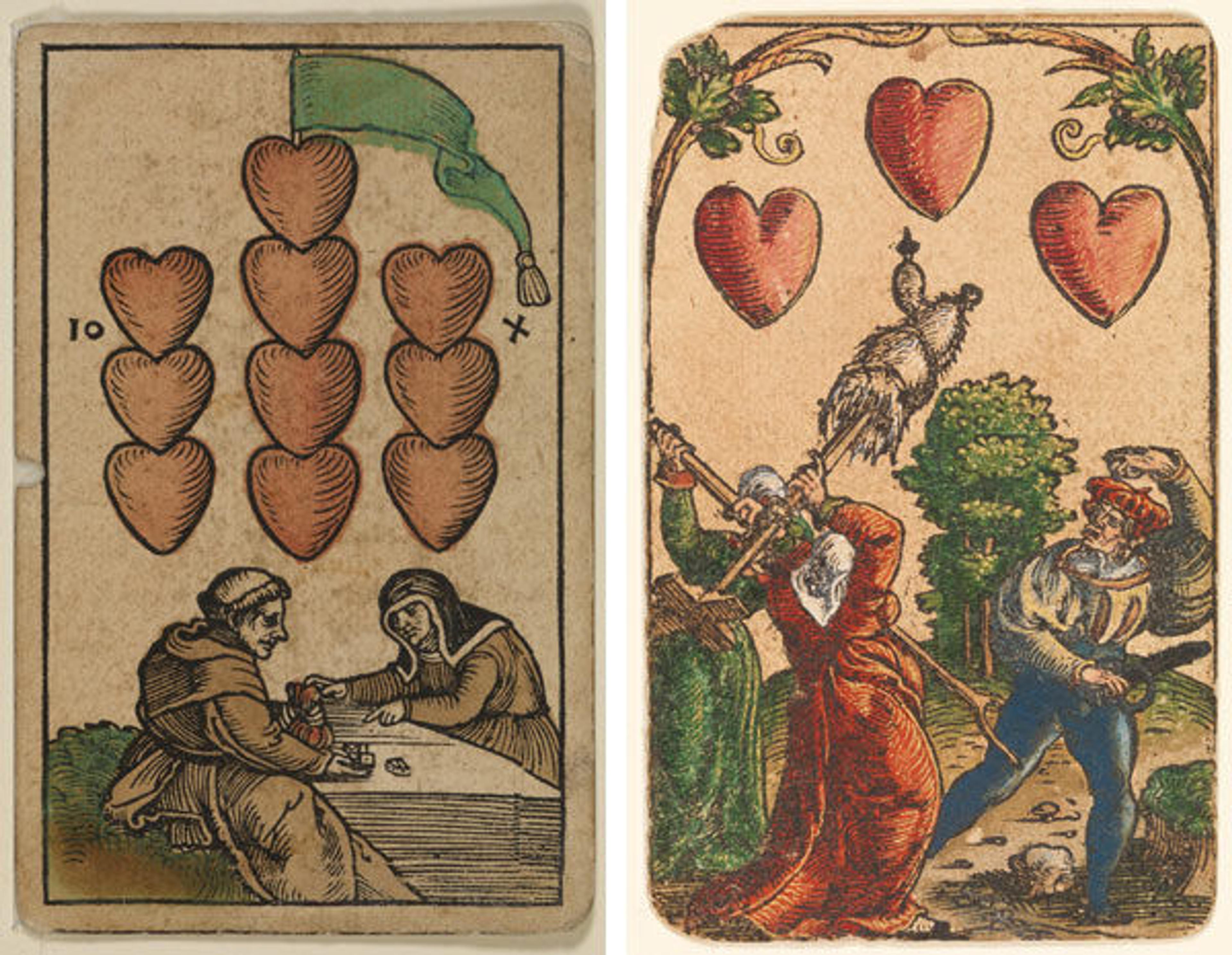
A medieval game of cards where Leafs and Hearts appear to be showing and chips or coins are in play. Master Ingold. Das Buch, das man mennt das Guldon Spil. Printed in Augsburg by Günther Zeiner, 1472. Von dem kartenspil. Woodcut and watercolor. Deutsches Spielkarten Museum, Landesmuseum Wurttemberg, Leinfelden-Echterdingen
«We know very little about the games played with the early European playing cards featured in the exhibition The World in Play: Luxury Cards, 1430–1540, on view through April 17. In the late Middle Ages and early modern times, card playing was widely enjoyed by all levels of society, perhaps because it was more challenging than dice and other games of pure chance yet less cerebral than chess. »
The cards themselves are not a game but the means for one, and the games played at the time are as varied as those who played them. This was particularly true before decks were standardized; without uniform decks there could be no codified games that all could play.

Workshop of Bonifacio Bembo (Italian, Cremonese, active ca. 1442–died before 1482). World, from The Visconti Tarot (detail), ca. 1450. Made in Milan, Italy. Paper (pasteboard) with opaque paint on tooled gold ground; 7 3/8 x 3 1/2 in. (18.9 x 9 cm). Beinecke Rare Book & Manuscript Library, Yale University, New Haven, Connecticut (ITA 109)
Sermons and treatises condemning card games make it clear that usually gambling was involved, which authorities felt all too often resulted in violence and penury. Many games, such as tarot in Italy and Karnöffel in Germany, involved trick taking. Other games had trump cards based on social ranks, the higher trumping the lower. In one variation, however, the reverse was the rule—a twist that, no doubt, did not please the authorities.

Left: A nun and a monk playing cards while the monk clutches a bag of money. This imagery appears to be a poke at the purported hypocrisy of the Catholic Church in post-Reformation eyes. Hans Schäufelein (German, ca. 1480–ca. 1540). 10 of Hearts, from The Playing Cards of Hans Schäufelein, ca. 1535. German, Nuremberg. Germanisches Nationalmuseum, Nuremberg. Right: Two women attack a young man with a pitchfork and distaff, the unwelcome consequence of an illicit entanglement. Peter Flotner (German, 1485–1546). 3 of Hearts, from The Playing Cards of Peter Flötner, ca. 1540. Made in Nuremberg, Germany. Woodcut on paper with watercolor, opaque paint, and gold; the d'Este arms are hand drawn in pen and ink on the 2 of every suit; each card: 4 1/8 x 2 3/8 in. (10.5 x 5.9 cm). Germanisches Nationalmuseum, Nuremberg (GMN Sp 7418 1–47 Kapsel 516)
Cards are mere ciphers, and the manner in which they are randomly dealt out is the mix with which each player must contend. Within the framework of rules and through imaginative thought and strategy, the cards in hand can be parleyed into success—or not.
The random conditions presented by a hand of cards could be likened to the circumstances one is born into. However, a game of cards has a distinct advantage: if you don't like the hand you were dealt, you can always draw another. In this sense, the playing out of a hand of cards is a microcosmic reflection of the ever-changing world around us—a world in play. The artists who created these cards seem to have shared this view.

3 of Bohemia, from The Courtly Household Cards, ca. 1450. German, Upper Rhineland. Kunsthistorisches Museum Wien, Kunstkammer
Related Link